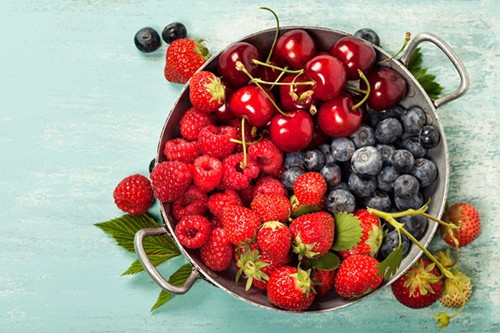
The plant kingdom boasts an arsenal of protective, naturally occurring chemical compounds that not only guard plants against foreign invaders and disease, but also benefit human health when eaten. One of the main types of plant compounds is anthocyanins, which are members of a group of phytochemicals called flavonoids. More than 600 structurally different anthocyanins have been found in nature. Best-known for the colorful pigments — including orange, red, purple and blue — they give fruits and vegetables, anthocyanins are revered for their potential ability to protect cells from free radical damage. However, research reveals anthocyanins also may help fend off an array of chronic diseases, such as cardiovascular disease and certain cancers.
Studying anthocyanins is challenging because it is difficult to isolate individual components. These complex “bioflavonoid” compounds work synergistically with other phytochemicals and nutrients to benefit human health. For example, when you eat a blueberry or sip a glass of red wine or green tea, you consume a complex mixture of flavonoid components. Research suggests anthocyanin activity is more effective when delivered in this type of mixture. However, what happens to anthocyanins after they are consumed and metabolized is somewhat of a mystery.
In recent years, methods to determine antioxidant activity in the cells have become more sophisticated; research has shown anthocyanins follow a different path than other flavonoids. Anthocyanins activate several signaling pathways, as well as crucial cellular processes that may fend off diseases and aid in health maintenance. These powerful pigments are consumed from a variety of plants; according to the U.S. Department of Agriculture’s Database on the Flavonoid Content of Selected Foods, the anthocyanincontaining foods consumed most are blueberries, strawberries, cherries, pears, red cabbage, cranberries, plums, raspberries and black beans.
Nutrients Frozen in Time
Because phytochemicals, such as anthocyanins, can degrade quickly, their potency is short-lived; therefore, steps must be taken to extend their viability from harvest to consumption. Research has found freezing fruits and vegetables can maximize their nutrient retention.
A recent study conducted at the University of California-Davis, with the Frozen Food Foundation, evaluated the nutrient content of eight frozen and fresh fruits and vegetables: blueberries, strawberries, carrots, corn, broccoli, green beans, green peas and spinach. Researchers examined the nutrient content of each under the following conditions: frozen — analyzed within 24 hours of harvest and then after 10 and 90 days in the freezer; fresh — analyzed at the time of harvest and after three and 10 days in the refrigerator. The results showed vitamins, minerals and dietary fiber content, as well as total phenolics, or organic compounds such as anthocyanins, were well-conserved in frozen fruits and vegetables compared to fresh.
Since colorful fruits and vegetables are packed with beneficial anthocyanins, among other phytochemicals, consuming a variety of them is the best way to reap their nutritional benefits. According to data from the National Health and Nutrition Examination (NHANES 2007-2010), Americans in every age group are not eating enough colorful fruits and vegetables to meet the recommendations of the 2015-2020 Dietary Guidelines for Americans. For adults, that is at least 2½ cups of vegetables and 2 cups of fruit per day for a 2,000-calorie healthy eating pattern.
Whole foods — not dietary supplements with isolated anthocyanin compounds — are linked to reduced risk of chronic diseases. Balanced, nutrient-dense foods with a myriad of natural plant compounds, vitamins, minerals and dietary fiber offer an optimal health advantage.
Where do anthocyanins fit in the flavonoid family?
There are five “subclasses” of flavonoids, each with unique plant compounds and beneficial effects. These are commonly consumed food sources of each type:
Flavonols: black tea, onions, apples
Flavan-3-ols: bananas, blueberries, peaches
Flavones: parsley, peppers, celery
Flavanones: oranges, lemons, tomatoes
Anthocyanins: blueberries, strawberries, cherries








